10 iconic images of historic Olympic moments
10 hours ago
By Deborah Nicholls-Lee,
 Alamy
AlamyFrom a 1920s American heartthrob swimmer to the famous Black Power podium salute, here are stunning images from new book The Last Heroes that capture the most tense and historic Olympic moments.
When the Olympic torches are lit in Paris on 26 July, the 206 participating countries will continue an ancient tradition, revived after a 1500-year pause when Athens staged the world’s first modern Olympics. It’s this event in 1896, attended by just 241 athletes, running in lanes delineated by rope and swimming in the Bay of Zea, that is the starting point for a new photographic history of the Summer Olympics. Published by Assouline, The Last Heroes – 100 Moments of Olympics Legend pays homage to history’s most extraordinary Olympians, and chronicles each Olympiad’s most unforgettable moments. Here are 10 of its most iconic images.
 Alamy
Alamy1. Johnny Weissmuller poses for artist John Hubbard Rich, c 1931
Paris last hosted the Olympics in 1924, when Johnny Weissmuller, the first swimmer to break the minute barrier for the 100m, won three gold medals and one bronze for the USA. Born into a German family in Hungary, Weissmuller was still a baby when, in 1905, the family boarded a boat to Ellis Island, New York to start a new life. Painted here by John Hubbard Rich for the Olympic Arts Competition (an event that ran from 1912 to 1948), this celebrity who had risen out of poverty became an emblem of athletic beauty and the American dream. His heartthrob credentials were cemented when he landed the lead in Tarzan the Ape Man in 1932, a role he reprised 11 times. After his death in 1984, it emerged that in 1924 Weissmuller was stateless, and had taken his younger brother’s identity to get into the US team. But his devotion to the US was never in doubt, with Senator Ted Kennedy and President Reagan arranging for a 21-gun salute at his funeral.
 Alamy
Alamy2. Adolf Hitler opens the Olympic Games in Berlin, 1936
Over the years, politics has often strayed into the Olympic arena, and images from the 1936 Berlin Olympics, three years into Adolf Hitler’s tenure, created a disturbing record of the regime’s show of strength at a Games where German Jewish athletes were not welcome. Germany’s attempt to use the event as a propaganda tool to celebrate Aryan superiority floundered given the stadium’s enthusiasm for 23-year-old Jesse Owens, a black American sprinter and long-jumper who won four gold medals and became the hero of the Games. Like many, he refused to do the Nazi salute on the podium. With Germany banned from the 1920 and 1924 Games – following World War One – hosting the 1936 edition should have been a turning point, but Hitler’s invasion of Poland in 1939 forced an eight-year hiatus in the Olympics, and the country was suspended from the event when it resumed in 1948.
 Alamy
Alamy3. Lis Hartel wins silver in Helsinki, 1952
In 1952, civilians and women were finally permitted to compete in equestrian events, a discipline that had previously been reserved for military personnel. At this stage, only dressage was open to women, and they were up against the men. None of this deterred 31-year-old Lis Hartel from Denmark from competing on her mare Jubilee – nor was she deterred by her disability. Eight years earlier, she had contracted polio, leaving her paralysed below the knee. Though she needed help mounting, her disability disappeared in the saddle, and she won the silver medal. Hartel later commented: “The hardest thing was to stand on the podium.”
 Getty Images
Getty Images4. Tommie Smith and John Carlos protest against segregation in Mexico City, 1968
In 1968, the Mexico City Olympics became an unwilling platform for the Civil Rights Movement when US 200m medallists Tommie Smith (gold) and John Carlos (bronze) took to the podium and raised black-gloved fists in a Black Power salute protesting against racial injustice. This overtly political act saw both suspended from the national team and sent home, where they faced death threats and abuse. “It was something that had to be done,” Smith told the BBC in 2012. “Did I want to do it? No.” In 2019, Smith’s name was finally added to the Hall of Fame at the US Olympic & Paralympic Museum in Colorado, a gesture which acknowledged that the act of rebellion that destroyed the career of the world’s fastest 200m runner had at least placed him on the right side of history.
 Getty Images
Getty Images5. Nadia Comăneci on the balance beam in Montreal, 1976
Until 14-year-old Nadia Comăneci from Romania took to the asymmetric bars in 1976, no Olympic gymnast had ever scored a perfect 10. Even the scoreboard was surprised: it had not been programmed to expect a 10, and a score of 1.00 appeared in its place. But if the scoreboard was stumped, the crowd was delighted, especially when the schoolgirl performed the feat over and over again, clocking up a total of seven 10s and securing three gold medals, one silver and a bronze. “Nobody told me that a perfect 10 was never scored before in Olympic history,” she told CBC Sports in 2017. “So I just went to do whatever I’d planned to do.”
 Alamy
Alamy6. Edwin Moses on an unbeaten hurdles streak in Los Angeles, 1984
Pictured here in 1984, US hurdler Edwin Moses was mid-way through a 10-year reign where he was unbeaten in the 400m hurdles. His huge stride, requiring just 13 steps rather than the standard 14, left his competitors trailing behind. When his streak came to an end, he made an unlikely career change to bobsledding, winning bronze with teammate Brian Shimer in the 1990 World Cup. But the hurdles remained his first love. “It’s the number one event for men and women on the planet,” he told running publication Citius Mag earlier this year. “It’s going to be one of the highlights for the Olympic Games.”
 Getty Images
Getty Images7. Florence Griffith-Joyner celebrates in Seoul, 1988
The US sprinter Florence Griffith-Joyner was working in a bank and had put her running career on hold when coach Bob Kersee coaxed her back to the track. When, at the Olympic trials, she smashed the 100m world record by 0.3 seconds, her competition knew they were in trouble. Tweny-eight-year-old “Flo-Jo”, with her long legs and long nails, was unstoppable in Seoul, breaking the world record for the 200m twice in one day. Sadly, an epileptic seizure cut her life short just 10 years later, but her 100m and 200m records remain unbeaten.
 Shutterstock
Shutterstock8. Hicham El Guerrouj makes track history in Athens, 2004
Eighty years after the “Flying Finn” Paavo Nurmi made history with his double 1500m and 5000m victory, a new competitor was stepping up to the starter blocks. Moroccan athlete Hicham El Guerrouj, the world record holder for the 1500m – still unbroken today – took gold in the 1500m, but he still had the 5000m to run, where competition is stiffer. In the final seconds of the race, El Guerrouj cut past the two lead runners and made it first across the finishing line. He held up two fingers: the elusive double is now part of his story, too. On the podium, he was overcome.
 Getty Images
Getty Images9. Usain Bolt dominates the men‘s sprinting in Beijing, 2008
The 6ft 5in Jamaican sprinter Usain Bolt trounced the competition at the Beijing Olympics, finishing the 100m, 200m and 4x100m strides ahead of the pack, and breaking three world records in the process. Joking around on the starting line and finishing up with his trademark To Di World victory pose, which he later patented, the charismatic athlete soon became the poster boy for the Beijing Olympics. But 2008 was just the beginning. The runner in the golden trainers went on to better his times and set new (unbroken) world records for the 100m, 200m and 4x100m relay. He also took gold for both the 100m and 200m in the two subsequent Olympic Games: a historic first.
 Getty Images
Getty Images10. Ryan Murphy and Caeleb Dressel celebrate the 4×100 medley relay in Tokyo, 2021
Despite pressure put on them by Great Britain’s Adam Peaty, the men’s nail-biting 4×100 medley relay saw Team USA set a new world record and hold on to the gold, a title that they had won in every Olympics, bar Moscow 1980, when the US boycotted the event following the Russian invasion of Afghanistan. But what’s perhaps most interesting about this image is what you can’t see: the restrictions imposed by the pandemic had stripped the stadium of spectators, with masked staff and athletes the only onlookers. Delayed by a year and enjoyed from the safe distance of our living rooms, Tokyo 2020’s Olympic flame brought welcome light during a dark period of our history.
Want to read more about the Olympics? Sign up for Medal Moments, your free global guide to Paris 2024, delivered daily to your inbox throughout the Games.









